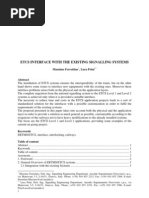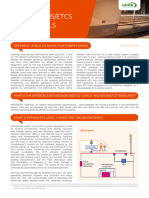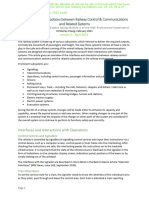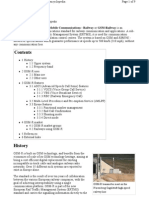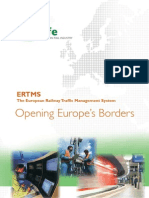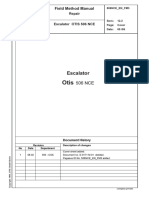Factsheet #: Ertms Levels
Factsheet #: Ertms Levels
Uploaded by
InuyashahanCopyright:
Available Formats
Factsheet #: Ertms Levels
Factsheet #: Ertms Levels
Uploaded by
InuyashahanOriginal Title
Copyright
Available Formats
Share this document
Did you find this document useful?
Is this content inappropriate?
Copyright:
Available Formats
Factsheet #: Ertms Levels
Factsheet #: Ertms Levels
Uploaded by
InuyashahanCopyright:
Available Formats
factsheet # 3
september 2017
TM
ERTMS LEVELS
DIFFERENT LEVELS TO MATCH CUSTOMER’S NEEDS
The ERTMS “levels” define different uses of ERTMS as a train control system, ranging from track to train
communications (Level 1) to continuous communications between the train and the radio block centre
(Level 2). Level 3, which is in specification development phase, will further increase ERTMS’ potential by
introducing a “moving block” technology and reducing trackside equipment for train detection. Whilst
it is commonly acknowledged that to date, ERTMS level 2 offers considerable benefits, the use of level 1
already brings significant advantages for the railways and allows for High Speed travel.
What is ERTMS level 1? What are the advantages?
ERTMS level 1 is designed as an add-on to or
overlays a conventional line already equipped
with lineside signals and train detectors.
Communication between the tracks and the
train is ensured by dedicated balises (known
as “Eurobalises®”) located on the trackside
adjacent to the lineside signals at required
intervals, and connected to the train control
centre. Receiving the movement authority
through Eurobalises, the ETCS onboard
equipment automatically calculates the
maximum speed of the train and the next
braking point if needed, taking into account
the train braking characteristics and the track
description data. This information is displayed The main benefits brought by ERTMS Level 1 are
to the driver through a dedicated screen in the interoperability (between suppliers and countries) and
cabin. The speed of the train is continuously safety, since the train will automatically brake if exceeding
supervised by the ETCS onboard equipment. the maximum speed allowed under the movement authority.
What is ERTMS level 2?
What are the advantages?
As opposed to level 1, ERTMS level 2 does
not require lineside signals. The movement
authority is communicated directly from a
Radio Block Centre (RBC) to the on-board unit
using a radio channel (GSM-R). The balises
are only used to transmit “fix messages”
such as location, gradient, speed limit, etc.
A continuous stream of data informs the
driver of line-specific data and signals status
on the route ahead, allowing the train to Whilst enabling greatly reduced maintenance costs through
reach its maximum or optimal speed but still the removal of lineside signals, ERTMS Level 2 also presents
maintaining a safe braking distance factor. the possibility for substantial line capacity increase by
enabling higher operational speeds and offering reduced
headways: more capacity means more trains moving, thus
more benefits.
ERTMS Level 2 provides the same interoperability and
safety benefits of Level 1.
What will be the features of ERTMS Level 3?
ERTMS Level 3, still in its conceptual phase,
introduces a “moving block” technology. Under
ERTMS level 1 and 2, movement authorities are
determined using “fixed blocks” - section of tracks
between two fixed points which cannot be used by
two trains at the same time. With ERTMS level 3,
accurate and continuous position data is supplied to
the control centre directly by the train, rather than
by track based detection equipment. As the train
continuously monitors its own position, there is no
need for “fixed blocks” – rather the train itself will
be considered as a moving block.
Is it possible to upgrade from one level to the other?
Yes – ERTMS allows for a smooth migration from one level to the other. For
instance, upgrading level 1 to level 2 mainly necessitates the installation of
the radio network, the Radio Block Centre and some additional balises for
positioning.
Introducing Level 3 will enable the train to monitor and report its own integrity
thus releasing the need for track detection circuitry e.g. axle counters and/or
track circuits.
Why should I opt for one ERTMS level or another?
ERTMS has been designed to meet the railways’ needs and this is reflected by
the different levels available. The existence of another signalling system on the
line, the possibilities to equip the line with GSM-R technology, the maximum
speed allowed or capacity upgrades, are amongst the factors which come
into play when choosing a particular ERTMS Level. However, it is commonly
acknowledged that ERTMS Level 2 brings the full benefit of the system to
a reality, as it allows for increased capacity and significant costs savings for
maintenance through the removal of lineside signals.
What is the difference between ERTMS
“levels” and ERTMS “baselines”?
ERTMS “baselines” (or System Requirements Specifications – SRS) designate the technical
baseline of the ERTMS software – the current legal versions are known as “2.3.0d” for
Baseline 2, 3.4.0 and the recently adopted 3.6.0 (which entered into force on 05 July 2016)
for Baseline 3. All currently operating levels are defined in each version of the SRS.
S u p p l i ers
© UNIFE 2018
Want to know more about ERTMS? Please check www.ertms.net or contact UNIFE at ertms@unife.org
You might also like
- Fordson Dexta Workshopmanual Part 2 of 2Document97 pagesFordson Dexta Workshopmanual Part 2 of 2sunny dhaliwalNo ratings yet
- Railway Signalling Systems PDFDocument103 pagesRailway Signalling Systems PDFAdetunji Taiwo75% (4)
- Mobile Network Optimization: A Guide for 2G and 3G Mobile Network OptimizationFrom EverandMobile Network Optimization: A Guide for 2G and 3G Mobile Network OptimizationRating: 3.5 out of 5 stars3.5/5 (3)
- Pithampur Company List: Designation Cmpany Name Contact No. Contact PersonDocument16 pagesPithampur Company List: Designation Cmpany Name Contact No. Contact PersonMuskan Thakur100% (3)
- Railway Signalling Systems PDFDocument103 pagesRailway Signalling Systems PDFAdetunji Taiwo100% (2)
- ETCSDocument14 pagesETCScavcicNo ratings yet
- Communications-Based Train Control (CBTC) Is ADocument18 pagesCommunications-Based Train Control (CBTC) Is AchaithanNo ratings yet
- COP1030 2.1 Program Overview FINAL SIN PGDocument16 pagesCOP1030 2.1 Program Overview FINAL SIN PGInuyashahanNo ratings yet
- Gilded Age - Viewing QuestionsDocument6 pagesGilded Age - Viewing QuestionsAmy GibbonsNo ratings yet
- Welcome To Aditya Birla Insurance Brokers Limited, A Subsidiary of Aditya Birla Capital Limited!Document3 pagesWelcome To Aditya Birla Insurance Brokers Limited, A Subsidiary of Aditya Birla Capital Limited!abcdNo ratings yet
- Bridge Inspection Manual-TXDOT (2013)Document147 pagesBridge Inspection Manual-TXDOT (2013)mehdi zalnezhadNo ratings yet
- ERTMS Factsheet 3 ERTMS LevelsDocument2 pagesERTMS Factsheet 3 ERTMS LevelsGuillermo García HernándezNo ratings yet
- Sheet 3 - Ertms Levels PDFDocument2 pagesSheet 3 - Ertms Levels PDFMoyGar2014No ratings yet
- ERTMSETCS Levels Updated 2024 EditionDocument2 pagesERTMSETCS Levels Updated 2024 EditionDonato ToccoNo ratings yet
- ERTMS by Michiel TomDocument9 pagesERTMS by Michiel TomSwathi ParasaramNo ratings yet
- Ansaldo ERTMSDocument7 pagesAnsaldo ERTMSpassworldgerezNo ratings yet
- ERTMS Appendix 2 Glossary enDocument10 pagesERTMS Appendix 2 Glossary enSamira ErramiNo ratings yet
- ERTMS - Exprience Afetr 2 Years in ItalyDocument11 pagesERTMS - Exprience Afetr 2 Years in ItalyMircea AlexoaiaNo ratings yet
- 153 Schuppan, RohanDocument7 pages153 Schuppan, RohanAmir ZulfiNo ratings yet
- Increase of Efficiency in Wireless Train Control Systems (Etcs Level 2) by The Use of Actual Packet-Oriented Transmission ConceptsDocument10 pagesIncrease of Efficiency in Wireless Train Control Systems (Etcs Level 2) by The Use of Actual Packet-Oriented Transmission ConceptsAnonymous HiQx2gFNo ratings yet
- ETCSDocument3 pagesETCSmita-balijaNo ratings yet
- Safe Train SeparationDocument4 pagesSafe Train SeparationbassamNo ratings yet
- ERTMSDocument8 pagesERTMSAnjali DSuzaNo ratings yet
- CSW - Railway - White Paper - ERTMS and CBTC Side by SideDocument4 pagesCSW - Railway - White Paper - ERTMS and CBTC Side by Sidejosemusic23No ratings yet
- ERTMS and CBTCDocument4 pagesERTMS and CBTCKereta KebalNo ratings yet
- ETCS - OverviewDocument13 pagesETCS - OverviewMuhammad Syahrul RamadhanNo ratings yet
- Figure 1: Electronic Interlocking For Mainline RailDocument11 pagesFigure 1: Electronic Interlocking For Mainline RailDhirendra InkhiyaNo ratings yet
- Integration Tests of ETCS on BoardDocument7 pagesIntegration Tests of ETCS on BoardMaalmalan KeekiyyaaNo ratings yet
- ERTMS Factsheet 1Document2 pagesERTMS Factsheet 1Donato ToccoNo ratings yet
- Ansaldo TPWSDocument6 pagesAnsaldo TPWSDFC PolicyNo ratings yet
- Performance Modelling Comparison of Train Control Systems: Abbreviation MeaningDocument3 pagesPerformance Modelling Comparison of Train Control Systems: Abbreviation Meaningwaqas_11No ratings yet
- 22 - Interfaces and Interactions Between Railway Control v2Document11 pages22 - Interfaces and Interactions Between Railway Control v2Jay JayNo ratings yet
- ERTMS/ETCS - Indian Railways Perspective: P Venkata Ramana, IRSSE, MIRSTE, MIRSEDocument6 pagesERTMS/ETCS - Indian Railways Perspective: P Venkata Ramana, IRSSE, MIRSTE, MIRSENitheesh Omanakuttan NairNo ratings yet
- European Railway Traffic Management System: ErtmsDocument9 pagesEuropean Railway Traffic Management System: ErtmsNitinNo ratings yet
- EuroRadio - PaperDocument11 pagesEuroRadio - PaperpassworldgerezNo ratings yet
- The European Rail Management System (Ertms)Document6 pagesThe European Rail Management System (Ertms)Ioana IzabelaNo ratings yet
- CBTCDocument5 pagesCBTCyadvikram7No ratings yet
- Mobile Train Radio CommunicataionDocument27 pagesMobile Train Radio CommunicataionKunal SharmaNo ratings yet
- 7.1.3 WCDMA Radio FundamentalsDocument3 pages7.1.3 WCDMA Radio FundamentalskkmNo ratings yet
- Trainspotting A WSN-Based Train Integrity SystemDocument6 pagesTrainspotting A WSN-Based Train Integrity SystemtejejeuNo ratings yet
- ERTMS in 10 QuestionsDocument8 pagesERTMS in 10 QuestionsMircea AlexoaiaNo ratings yet
- GSM RDocument9 pagesGSM RMohammad H KarimiNo ratings yet
- B - GERT8000 - RS525Document64 pagesB - GERT8000 - RS525dmeharyNo ratings yet
- 3.1 Operational Performance Signalling and ControlDocument72 pages3.1 Operational Performance Signalling and ControlmeidiNo ratings yet
- Safety Analysis of Cryptography Mechanisms Used in GSM For RailwayDocument6 pagesSafety Analysis of Cryptography Mechanisms Used in GSM For RailwayCristian LiviuNo ratings yet
- GSM-R: The Standardized DigitalDocument12 pagesGSM-R: The Standardized Digitalap0026No ratings yet
- MTRCDocument16 pagesMTRCPrapti AlokNo ratings yet
- ETCS - A Brief Overview: Shiv Mohan Sr. Signalling Design EngineerDocument47 pagesETCS - A Brief Overview: Shiv Mohan Sr. Signalling Design EngineerShashi Bhusan Singh100% (2)
- BCAC-502 CA-2 2022 21301220038 Priyanshu-KunduDocument6 pagesBCAC-502 CA-2 2022 21301220038 Priyanshu-Kundupriyanshuwork.10No ratings yet
- GSM-R To LTE For Railways in IndiaDocument4 pagesGSM-R To LTE For Railways in IndiaPulin ChaudhariNo ratings yet
- Article 22Document3 pagesArticle 22Sandeep KumarNo ratings yet
- Modelization of The Rail Traffic Management System - English - SVTDocument6 pagesModelization of The Rail Traffic Management System - English - SVTmita-balijaNo ratings yet
- Multiplexing PPT Ch12 7th EditionDocument32 pagesMultiplexing PPT Ch12 7th Editionparkerroach21No ratings yet
- Layer 3 - Umts PDFDocument49 pagesLayer 3 - Umts PDFSukrit Chaudhary100% (6)
- UNIT3NGNDocument5 pagesUNIT3NGNshubham chauhanNo ratings yet
- Train Monitoring SYSTEMDocument15 pagesTrain Monitoring SYSTEMMichael WilliamsNo ratings yet
- Opening Europe's Borders: A European Success StoryDocument8 pagesOpening Europe's Borders: A European Success Storyapi-19765942No ratings yet
- Cisco Certified Network Associate (CCNA) and Cisco Certified Network Professional (CCNP): Mastering Network Automation and Programmability Study GuideFrom EverandCisco Certified Network Associate (CCNA) and Cisco Certified Network Professional (CCNP): Mastering Network Automation and Programmability Study GuideNo ratings yet
- Train Headway Models and Carrying Capacity of Super-Speed Maglev SystemDocument5 pagesTrain Headway Models and Carrying Capacity of Super-Speed Maglev SystemInuyashahanNo ratings yet
- High Speed Railway CapacityDocument9 pagesHigh Speed Railway CapacityInuyashahanNo ratings yet
- S2RAST-WP2-D-S2R-001-01 - D2.1 Modelling of The Moving Block Signalling SystemDocument44 pagesS2RAST-WP2-D-S2R-001-01 - D2.1 Modelling of The Moving Block Signalling SystemInuyashahanNo ratings yet
- UK BIM Alliance, BSI & CDBB Launch UK BIM FrameworkDocument2 pagesUK BIM Alliance, BSI & CDBB Launch UK BIM FrameworkInuyashahanNo ratings yet
- Lav98c PDFDocument4 pagesLav98c PDFSteve LaValleNo ratings yet
- Assembly Manual: Sweep AugerDocument14 pagesAssembly Manual: Sweep AugerGREGORIO SANTIAGO RODRIGUEZ ROMERONo ratings yet
- Wireless Power Transfer For Electric Vehicle: University of Padova, ItalyDocument142 pagesWireless Power Transfer For Electric Vehicle: University of Padova, ItalyVenkat GoudNo ratings yet
- Chapter3OverhaulDocument16 pagesChapter3OverhaulangelNo ratings yet
- Front Axle ShaftsDocument12 pagesFront Axle ShaftsKammoeNo ratings yet
- Story'telling Cerita RakyatDocument5 pagesStory'telling Cerita RakyatBrow Nies ParlayNo ratings yet
- ETS 토익정기시험 기출입문서 LC 온라인모의고사Document12 pagesETS 토익정기시험 기출입문서 LC 온라인모의고사꽃개No ratings yet
- Crash ExercisesDocument3 pagesCrash ExercisesAriana Karounos-ShaunNo ratings yet
- SG21-3 Operation and Maintenance Manual 2018.12.19Document130 pagesSG21-3 Operation and Maintenance Manual 2018.12.19Jalen JonesNo ratings yet
- RE-Drawing Stowage LCTDocument3 pagesRE-Drawing Stowage LCTmifahmiamiNo ratings yet
- IATCO Catalog 07.2020Document24 pagesIATCO Catalog 07.2020Edwin KaNaNo ratings yet
- KGM e Motion Tekniset Tiedot 2023 8Document1 pageKGM e Motion Tekniset Tiedot 2023 8Markus VäliviitaNo ratings yet
- Cartilla de Reparacion Corolla Negro KINALDocument10 pagesCartilla de Reparacion Corolla Negro KINALNico ArtNo ratings yet
- Escalator: Field Method ManualDocument145 pagesEscalator: Field Method ManualOsman Elmaradny100% (7)
- Container Reach Stacker Safety BookDocument29 pagesContainer Reach Stacker Safety Booksudaryanto100% (2)
- Key Concepts of Physical DistributionDocument21 pagesKey Concepts of Physical DistributionRataNo ratings yet
- Renault MEGANE 2016 - Driver’s Handbook - 09 2015 - Edition Anglaise (États Unis)Document316 pagesRenault MEGANE 2016 - Driver’s Handbook - 09 2015 - Edition Anglaise (États Unis)Edilson do ValleNo ratings yet
- Tito Joy Cabigaan-Layout1Document1 pageTito Joy Cabigaan-Layout1Kevin Suerte CanillaNo ratings yet
- Subject: Insufficient Fuel Tank Wall Thickness/Fuel Leak: 1200 New Jersey Avenue SE Washington, DC 20590Document2 pagesSubject: Insufficient Fuel Tank Wall Thickness/Fuel Leak: 1200 New Jersey Avenue SE Washington, DC 20590Afzal ImamNo ratings yet
- Maglev Wind MillDocument33 pagesMaglev Wind Millritesh chauhanNo ratings yet
- Bills of LadingDocument4 pagesBills of LadingFrancis Castillo100% (1)
- PL CD1465 CD1480 ENG Rev1Document96 pagesPL CD1465 CD1480 ENG Rev1dtolind smtpNo ratings yet
- Grazia Repsol BrochureDocument4 pagesGrazia Repsol BrochureAbhinav SinghNo ratings yet
- ATR-72 Flight Crew ManualDocument20 pagesATR-72 Flight Crew ManualCrispyNo ratings yet
- What Are The Major Problems Faced by Freight ForwardersDocument12 pagesWhat Are The Major Problems Faced by Freight ForwardersHaryo ChristiantoNo ratings yet
- Fault Code ListDocument9 pagesFault Code ListPT. GLOBAL MULTI TRAKTORNo ratings yet






